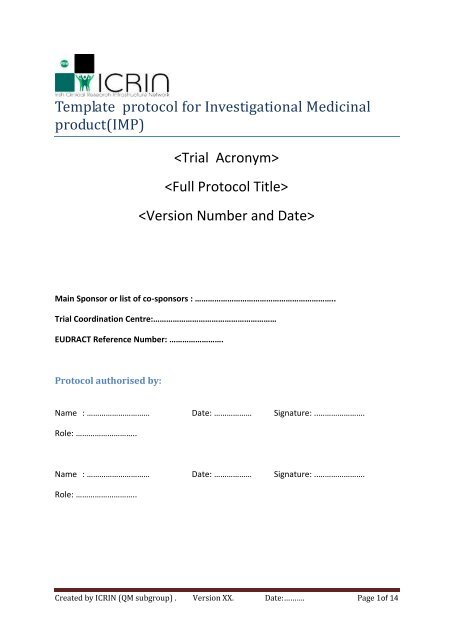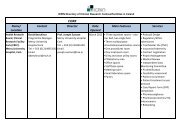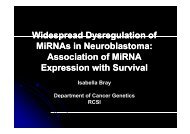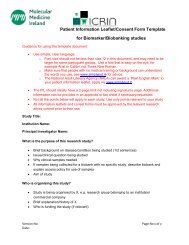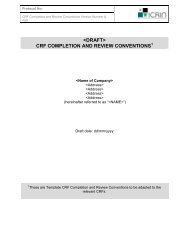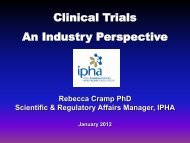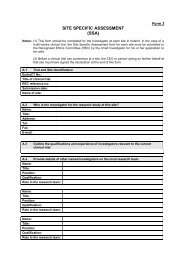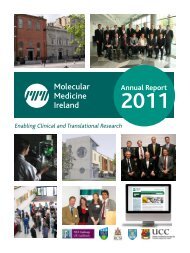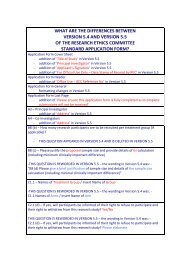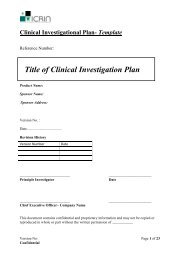Template protocol for Investigational Medicinal product(IMP)
Template protocol for Investigational Medicinal product(IMP)
Template protocol for Investigational Medicinal product(IMP)
You also want an ePaper? Increase the reach of your titles
YUMPU automatically turns print PDFs into web optimized ePapers that Google loves.
6El sitio de la American Family Physician, suobjetivo principal es ofrecer <strong>for</strong>mación continuadaa médicos de atención primaria. Publican artículosoriginales sencillos y prácticos elaborados de<strong>for</strong>ma libre, mediante revisiones clínicas, revisiónde evidencias u opinión propia, siempreorientados a la resolución de problemas en elcuidado de los pacientes.DirectoriosEn Internet se disponen de directorios de revistassanitarias que de manera sencilla nos permitenacceder a la sede de los editores:Periodici Elettronici Biomedicihttp://aib.it/aib/commiss/cnur/peb/peb.htm3Uno de los más completos y de uso muy sencillo.Free Medical Journalshttp://www.freemedicaljournals.com/index.htmRecoge las revistas que están gratuitas a textocompleto.Directorio de Revistas Sanitarias Españolaswww.fisterra.comPrograma de Actividades Preventivas y dePromoción de la SaludEl Programa de Actividades Preventivas y dePromoción de la Salud (PAPPS) es un proyectopatrocinado por la Sociedad Española deMedicina Familiar y Comunitaria (SEMFyC) yasumido por una red de centros de atenciónprimaria españoles. Se puso en marcha en enerode 1989 para estimular la calidad asistencialintegrando un programa de actividadespreventivas y de promoción de la salud en el senode las tareas desarrolladas habitualmente en lasconsultas de Atención Primaria. Elaborarecomendaciones periódicas de prioridades ymétodos preventivos basándose en evidenciascientíficas mediante grupos de expertos conmétodos de consenso. En este sitio podemosencontrar guías, generalmente en <strong>for</strong>mato PDF,sobre:• Prevención y promoción de la salud en lainfancia y la adolescencia• Recomendaciones preventivascardiovasculares: aplicaciones prácticas delriesgo cardiovascular• Prevención del cáncer• Prevención de las enfermedadestransmisibles• Recomendaciones sobre el estilo de vida• Prevención de los trastornos de la saludmental desde la atención primaria de saludAdemás de in<strong>for</strong>mes técnicos, guías de educaciónsanitaria y otras publicaciones ocasionales, lasemFYC dispone de una serie de documentostécnicos en soporte papel de la máxima calidad einterés, no disponibles en la red.Sociedad Andaluza de Medicina Familiar yComunitariaLa Sociedad Andaluza de Medicina Familiar yComunitaria (SAMFYC) elaboró diversas guíasmuy interesantes mediante grupos de trabajosobre:• Diabetes mellitus• Salud MentalEsta última guía es probablemente la máscompleta de las editadas en español. Enlaza enun Anillo hispano de la Diabetes con otrosdocumentos sobre el tema. Este es un anillo web,creado con el propósito de albergar el mayornúmero de páginas web que traten el tema de laDiabetes, utilizando como idioma el español. Está<strong>for</strong>mado por páginas de distintos usuarios quecontienen enlaces entre sí. Mediante estosenlaces se puede navegar recorriendo todas laspáginas. La SAMFyC tiene otro grupo trabajandoen Hipertension arterial con una página en dondese puede encontrar abundantes y seleccionadosrecursos relacionados con la HTA: revistas,reuniones, publicaciones, artículos comentados yun <strong>for</strong>o sobre HTA.Pediatría Basada en la EvidenciaEn España, los recursos disponibles en la Redsobre Pediatría Basada en la Evidencia han sidoiniciativas personales, pero sus páginas puedenconsiderarse como las de mejor calidad en elárea de ciencias de la salud.• Asociación Española de Pediatría Basadaen la Evidenciahttp://www.aepap.org/recientemente inaugurada, es sin duda,uno de los mejores portales sanitarios españoles• GAIBE. Grupo de Asma Infantil Basadoen EvidenciasESPAÑOLGAIBEEn España el grupo GAIBE (Grupo de AsmaBasado en la Evidencia) está llevando a caborevisiones sistemáticas sobre “Asma infantil”.Podemos consultarlas en su pa´gina de Internet(http://www.infodoctor.org/respirar/gaibeinicio.htm).http://www.infodoctor.org/respirar/gaibeinicio.htm• Pediatría Basada en la Evidencia. JoséCristobal Buñuel Álvarezhttp://www.infodoctor.org/pbe/• Respirar. Carlos A. Díaz Vázquezhttp://www.infodoctor.org/respirar/index.htm• TESA. Thesaurus de las evidencias sobreasma . Carlos A. Díaz Vázquezhttp://www.infodoctor.org/respirar/tesa1.htmDirectorios sobre MBEMedicina Basada en la Evidencia. Rafael Bravohttp://www.infodoctor.org/rafabravo/mbe.htm
describe the procedures <strong>for</strong> stopping the trial early. Describe the procedures <strong>for</strong>subjects should they wish to withdraw their consent, i.e. will all data to-date be held,will all data be destroyed>4.6 Concomitant Medication and Treatment5. SCHEDULE OF ASSESSMENT6.RANDOMISATION AND ENROLMENT PROCEDURE6.1 RANDOMISATION OR REGISTRATION PROCEDURE6.2 UNBLINDING7. TREATMENTS7.1TREATMENT ARMS
7.4INTERACTION WITH OTHER DRUGS7.5DISPENSING AND ACOUNTABILITY< Procedures <strong>for</strong> the pharmacy on dispensing and per<strong>for</strong>ming drug accountability should beincluded>8. DRUG SAFETY (Pharmacovigilance)The sponsor is responsible <strong>for</strong> the ongoing safety evaluation of the investigational <strong>product</strong>(s). Thesponsor should promptly notify all concerned investigator(s)/institution(s) and the competentauthorities (CAs) of finding(s) that could affect adversely the safety of subjects, (ICHGCP 5.16). TheSponsor should also follow ICHE2A (Guideline <strong>for</strong> Industry, Clinical Safety Data Management,Definitions and Standards <strong>for</strong> Expedited Reporting.8.1. DEFINITIONS (ICH E2A)Adverse Event or Adverse Experience(AE): Any untoward medical occurrence in a patient orclinical trial subject administered a pharmaceutical <strong>product</strong> and which does not necessarilyhave a causal relationship with this treatment.An AE there<strong>for</strong>e can be any unfavourable and unintended sign, symptom( including anabnormal laboratory finding), symptom, or disease temporally associated with the use of an<strong>Investigational</strong> <strong>Medicinal</strong> Product (<strong>IMP</strong>), whether or not considered related to the <strong>IMP</strong>.Adverse Drug Reaction (ADR): In the pre-approval clinical experience with a new medicinal<strong>product</strong> or its new usages, particularly as the therapeutic dose(s) may need to beestablished.All noxious and unintended responses to a medicinal <strong>product</strong> related to any dose should beconsidered adverse drug reactions.The phrase “responses to a medicinal <strong>product</strong>s” means a causal relationship between amedicinal <strong>product</strong> and an adverse event is at least a reasonable possibility i.e. therelationship cannot be ruled out. All AEs judged by either the reporting investigator or thesponsor as having a reasonable causal relationship to a medicinal <strong>product</strong> qualify as adversedrug reactions. The expression reasonable causal relationship means to convey in generalthat there is evidence or argument to support a causal relationship.Unexpected Adverse Drug Reaction (UAR): An adverse drug reaction , the nature andseverity of which is not consistent with the applicable <strong>product</strong> in<strong>for</strong>mation (e.g.IB or SmPC)or is more severe than described in the IB or SmPC then this should be considered asunexpected e.g (a) acute renal failure in the IB/SmPC with a subsequent report ofinterstitial nephritis, (b) hepatitis with a first report of fulminant hepatitis.Serious Adverse Event (SAE) or Serious Adverse Reaction: Any untoward medicaloccurrence or effect that at any dose:Created by ICRIN (QM subgroup) . Version XX. Date:………. Page 8of 14
Results in DeathIs Life-threatening( Note: The term life-threatening in the definition of serious refers to an event inwhich the patient was at risk of death at the time of the event; it does not refer toan event which, hypothetically might have caused death if it was more severe)Requires hospitalisation or prolongation of hospitalisationResults in persistent or significant disability or incapacityIs a congenital anomaly or birth defectMedical judgement should be exercised in deciding whether expedited reporting is requiredin other situations, such as important medical events that may not be immediately lifethreateningor result in death or hospitalisation but may jeopardise the patient or mayrequire intervention to prevent the other outcomes listed in the definition above. Theseshould also be considered serious.Examples of such events are internsive treatment in an emergency room or at home <strong>for</strong>allergic bronchospasm, blood dyscrasias, or convulsions that do not result in hospitalisation;or development of drug dependency or drug abuse.Suspected Unexpected Serious Adverse Reaction (SUSAR): Any suspected adverse reactionrelated to an <strong>IMP</strong> that is both unexpected and serious. All require expedited reporting.8.2 CAUSALITYCausality assessment is required <strong>for</strong> clinical investigational cases, it is assumed in the case ofadverse event reports associated with marketed drugs.The causality assessment and assignment should be made by the investigator responsible <strong>for</strong>the care of the subject using the definitions indicated below.RelationshipUnrelatedUnlikelyPossibleDescriptionThere is no evidence of a causal relationshipThere is little evidence to suggest there is a causal relationship( e.g the event did not occur within a reasonable time afteradministration of trial medication). There is anotherreasonable explanation <strong>for</strong> the event (e.g. concomitantmedications, clinical condition)There is some evidence to suggest a causal relationship (e.g.event occurs a reasonable time after administration of trialCreated by ICRIN (QM subgroup) . Version XX. Date:………. Page 9of 14
medication, temporal relationship). However, the influence ofother factors may have contributed to the event (e.g.concomitant medications, clinical condition)ProbableDefinitelyNot assessableThere is evidence to suggest a causal relationship and theinfluence of other factors is unlikely.There is clear evidence to suggest a causal relationship andother contributing factors cannot be ruled out.There is insufficient or incomplete evidence to make a clinicaljudgement of the causal relationship.8.3 REPORTING PROCEDURESAll adverse event require reporting. Different reporting procedures are appropriate <strong>for</strong>differing types of adverse events.1. Non serious AR/AEAll such events should be captured in the AE section of the CRF and sent to the DataManagement coordinating centre on a regular basis <strong>for</strong> entry into the Clinical Databaseand inclusion in the Annual Safety Reports.2. SAEsEvents which fulfil the seriousness criteria, or are medically significant should be bothentered into the CRF and a signed SAE <strong>for</strong>m should also be completed and faxed to thecoordinating centre <strong>for</strong> Drug safety within 24 hours. However, hospitalisations <strong>for</strong>elective treatment of a pre-existing condition do not require reporting as an SAE3. SUSARsAll Serious Adverse Events that are unexpected as per the IB or SmPC are SUSARs andrequire expedited reporting.The in<strong>for</strong>mation <strong>for</strong> SUSARs should be entered into the Clinical database, and a signedSAE <strong>for</strong>m should also be completed and faxed to the coordinating centre <strong>for</strong> Drug safetywithin 24 hours or alternatively the in<strong>for</strong>mation can be provided by phone and acompleted and signed SAE <strong>for</strong>m sent within 24 hours as above.The drug safety coordinating centre will report to relevant CA, REC and EMEA and the Sponsor of allSUSARs occurring in the trial to the following timelinesCreated by ICRIN (QM subgroup) . Version XX. Date:………. Page 10of 14


